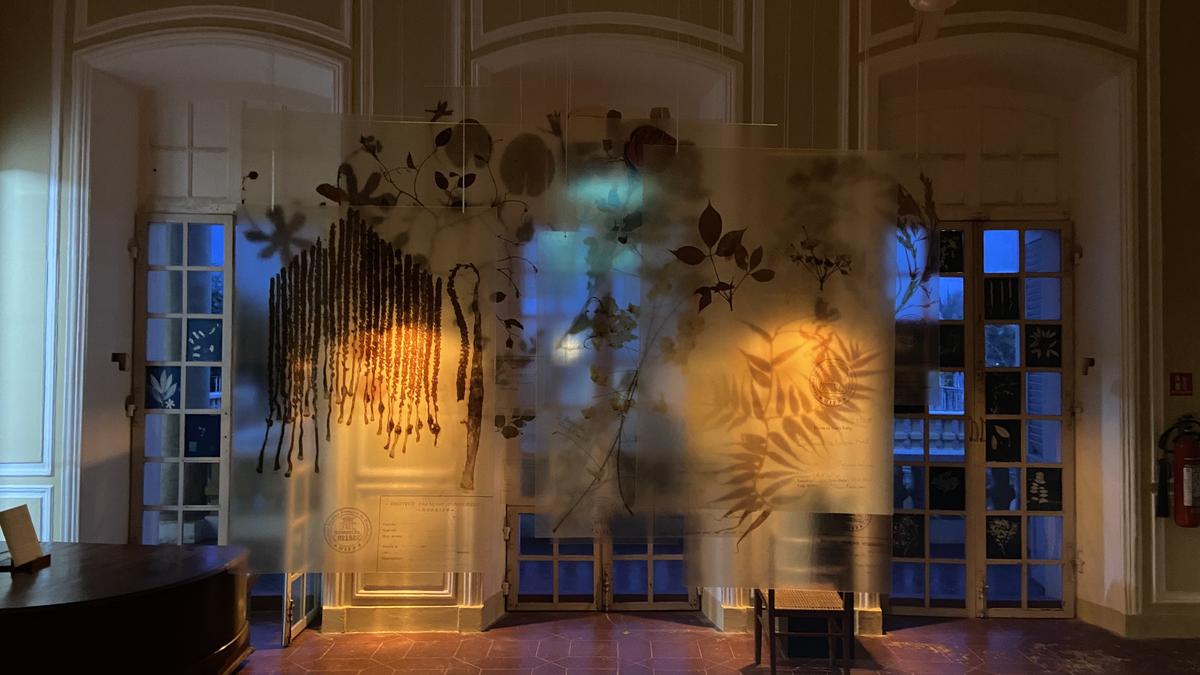
At Puducherry, rare photo archives and research material transform into an art show
The Hindu
From transparent prints, an Excel scroll and cabinets of photographs: spread across the first floor of the French Institute of Pondicherry is an artistic display of the research institute’s archival wealth
The staircase leading up to the first floor of the French Institute of Pondicherry (IFP) today tells a story: in the literal sense. On each step is a sentence that pushes one to pause and ruminate. This is only a precursor to what is to come once you enter the all-too-familiar building with a yellow facade where mandatory vacation photos are taken. It sets the context for the immersive world that waits inside.
Sleepwalker Archives, a multi-disciplinary exhibit that spreads across the first floor of the building, is a delightful marriage of mediums — here, text, archival images, film and even physical objects come together in an attempt to re-interpret the existing wealth of archival material that the institute is a proud home to.
The project initiated by the India Foundation for the Arts (IFA) based in Bengaluru, selected curators Karthik Subramanian, Devarati Chakrabarti and Sujeet George to engage with IFP’s archives, 15 months ago. The archives are three-fold; one with over 1,30,000 to 1,40,000 images of South India, largely Tamil Nadu, from the 1950s that include depictions of South Indian cultural aspects like temple imagery and documentation of Puducherry. The second, is the Stars Collection, a digitised documentation of images and materials from photo studios across the State while the third, points to the research institute’s exceptional herbarium collection with 25,000 plant specimens. The curators say that it took them a month to put together the set up.
“It was interesting that each of us were looking at the same material with completely different perspectives and starting points. We kept talking about our engagements and at one point thought it would be nice to put our individual outputs together. It then grew bigger,” says Karthik. Devarati adds, “We were simply trying to make sense of the sheer volume of information we had to interact with.”
The idea of creating a fictional space then came to be. The narrative is carried by a fictional persona whose identity is still not defined. “The story begins on the steps leading up to this space. As people walk up, they begin with reading a person’s reflection on the need for documentation and archiving,” says Karthik. But not necessarily in an orderly fashion. They are presented with the possibilities of documenting scientific material by creating space for play and whimsy.
Clues and surprises jump at one in every corner. Even objects like the many wooden cabinets in the institute are part of the display. “We have repopulated the cabinets with some poetic keywords that are usually not used to categorise the material here,” continues Karthik. The cabinets have 66 drawers with images with accordion folds that spill out and single images with text. Some of the tools and instruments used for the herbarium research are also part of the narrative display.
Another installation is a 10-metre-long Excel scroll that hangs like a curtain with a meticulous list of the flora specimens from the archive. What makes it interesting is a rather unexpected comparison with Sangam poetry. Karthik explains, “There is a Sangam poem called kurincipattu, which has a sudden moment of deviation, where 99 flowers are listed back to back. It is kind of a geographical archive.” The central, fictional character attempts to spot the names in the list. The idea is to enable a seamless conversation between the ancient poem and contemporary scientific database. The display is also home to transparent prints of the archival images of the flowers that hang in the space. An audio booth with a collection of Sangam poems in English and Tamil also make up the narrative, apart from a fictional film by Karthik.











